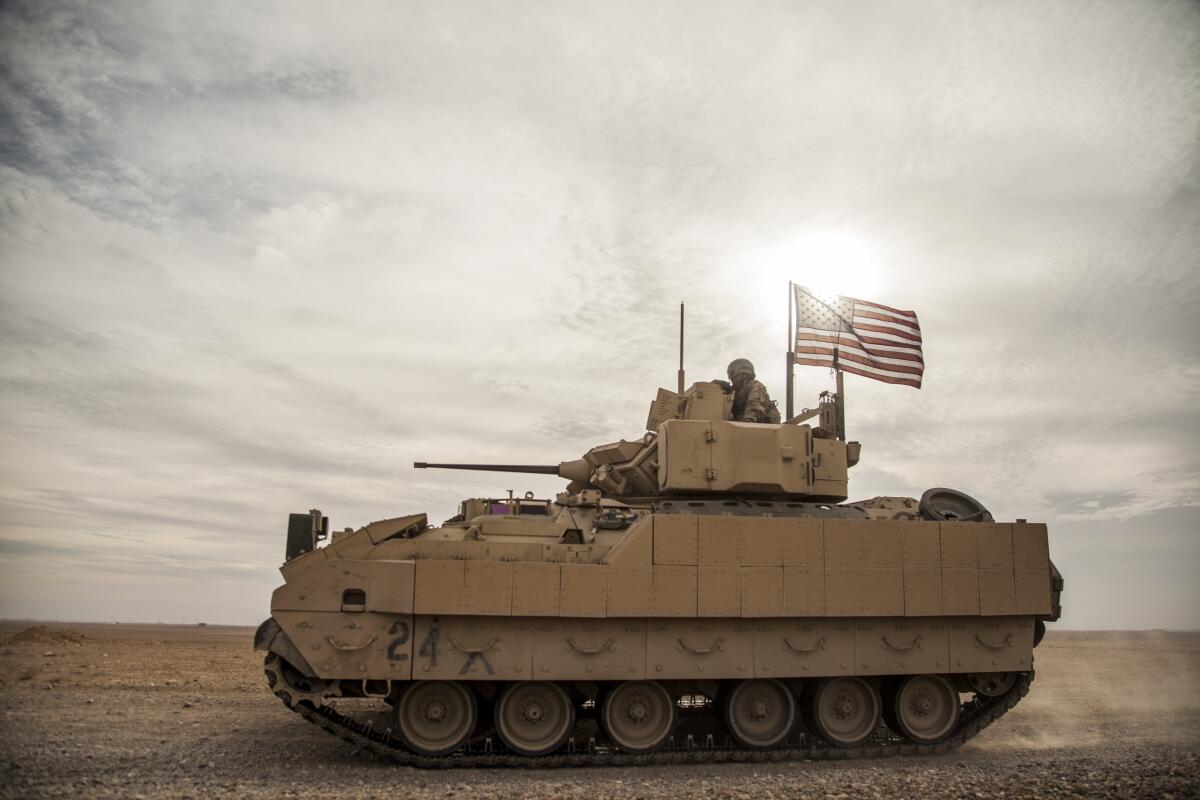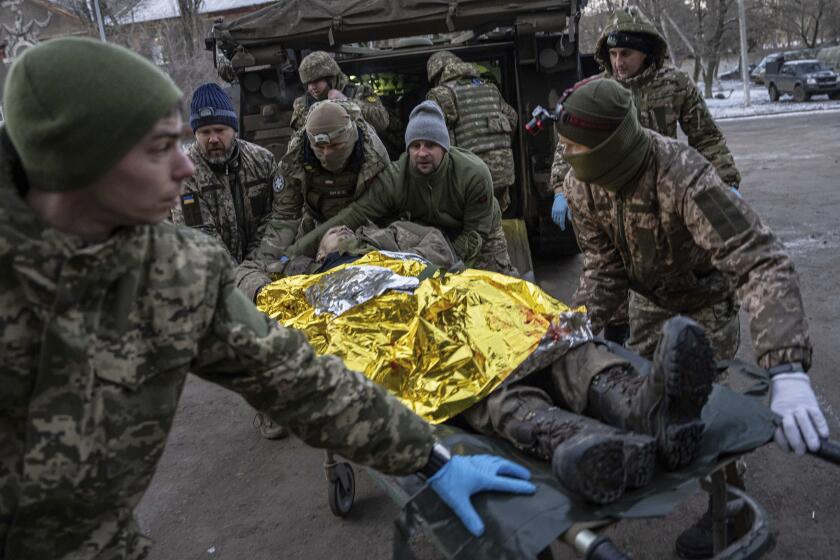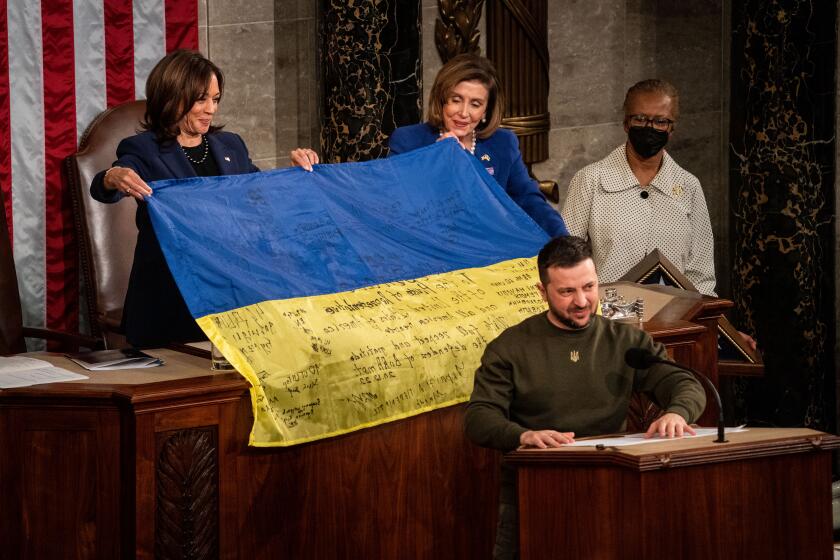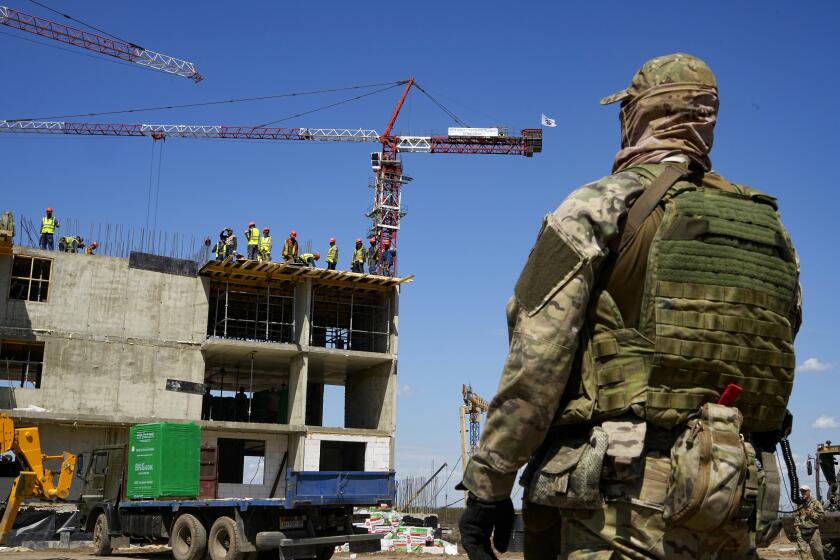U.S. and Germany are sending armored vehicles to Ukraine. Will they help?

- Share via
WASHINGTON — Looking ahead to a likely spring offensive, the U.S. and Germany are sending Ukraine an array of armored vehicles, including 50 tank-killing Bradleys, to expand its ability to move troops to the front lines and beef up its forces against Russia as the war nears its first anniversary.
The vehicles don’t fulfill Ukraine’s request for combat tanks. But they provide a strategic war-fighting capability as the season change brings muddy terrain and Ukraine launches a campaign to recapture territory taken by Russia, particularly in the east.
A look at the Bradley and other armored carriers, and what they bring to the fight:
What are they, and how will they help?
They are not tanks. The Bradleys and the 40 German Marders are among a wide variety of armored personnel carriers used by Western nations. They are designed to fit into what advanced militaries call a combined arms maneuver fight — the ability to use a wide range of ground, air and other weapons and fighting units in seamless coordination to win a battle.
The M2A2 Bradley is a medium-armored combat vehicle that has tracks rather than wheels, but is lighter and more agile than a tank. It can carry a crew of three and an additional five or six troops, and is seen as a critical way to move infantry squads safely into battle.
It is generally armed with a 25-millimeter gun mounted on the top, a machine gun and an antitank TOW missile launcher that can be used when the Bradley is stopped. “TOW” stands for “tube-launched, optically tracked, wire-guided,” which means the missile is fired only at targets that troops can actually see on the battlefield, so it’s very effective in open spaces such as deserts and large fields.
Russian forces are escalating their onslaught on Bakhmut, bringing new levels of death and devastation to the already-wrecked city in east Ukraine.
The Marder is similar, and can carry largely equivalent weapons.
In a combined arms fight, for example, Ukrainian forces could fire rounds of artillery and airstrikes into a Russian stronghold, and then quickly move infantry troops in armored vehicles to the front for a ground assault to take advantage of Russia’s weakened state.
“It creates a dilemma for adversaries,” said Bradley Bowman, senior director of the Center on Military and Political Power at the Foundation for Defense of Democracies, adding that using the Bradleys will allow Ukraine’s forces to exploit soft spots created by the artillery barrages. “It’s a powerful combination.”
Both Russia and Ukraine have suffered heavy losses of tanks and other armored vehicles in the last 10 months, so sending the Bradleys and Marders will help offset those losses.
Why now?
The decision to send the Bradleys reflects a steady progression in the complexity and lethality of the weapons systems that the U.S. and its allies have provided over the course of the war.
Many condemn the pace as too slow, arguing that Ukraine needs everything it can get to repel the Russians and that some territory losses could have been prevented if the U.S. and its allies had moved faster.
Others counter that the types of weapons provided have shifted based on the changing nature of the war since it began last February, and the growing ability of Ukrainian troops to travel out of the country to get the training they need to operate and maintain more complicated and high-tech systems.
The Ukrainian president, on a dangerous trip from his war-torn country, addressed Congress in an attempt to shore up support from his most important ally.
White House National Security Council spokesman John Kirby told reporters Friday that the Bradley would be helpful as the fight escalates in the eastern Donbas region, where there is “a lot of farmland, a lot of open ground.” The decision, he said, reflects Ukraine’s current military needs, but is “also taking a look at what the fight is likely to be.”
At the Pentagon, Laura Cooper, the deputy assistant secretary for Russia and Ukraine, said this was the right time to provide Bradleys.
“The Ukrainians have demonstrated a lot of growing proficiency in maintenance and sustainment,” she said. She added that the U.S.-led training set to begin later this month would enable troops to operate, maintain and repair the weapons.
The U.S. and other allies are also using the winter months to send large amounts of weapons and equipment that Ukraine will need when fighting heats up in the spring.
Thanks but no tanks
Ukraine has persistently asked for tanks, but the U.S. and other allies have resisted sending the heavier, more powerful and complex armored vehicles.
America’s M1 Abrams tank, for example, carries a far more powerful gun and is more heavily armored, but weighs a lot more and uses jet fuel rather than diesel. All of that makes it more difficult to maintain and sustain as troops are on the march.
Throughout the occupied Ukrainian city of Mariupol, Russian workers are tearing down bombed-out buildings and hauling away bodies along with debris.
“We absolutely agree that Ukraine does need tanks,” said Cooper. “But we have to be cognizant of maintenance and sustainment considerations with tanks. And certainly we know that the Abrams tank, in addition to being a gas guzzler, is quite challenging to maintain.”
She said that was why the U.S. partnered with the Netherlands to refurbish T-72 Soviet-era tanks that Ukrainian troops would already know how to use.
The U.S. and other Western nations have trained and practiced for decades how to move troops in combat so that critical food, fuel and supplies keep pace with the forces. Russia’s inability to do that was on display early in the war when its long troop convoy heading toward Kyiv stalled, because troops were without food and fuel, owing to a total logistical breakdown.
When will the vehicles arrive?
U.S. and German officials would not provide precise timelines for when the training would finish and how quickly the armored vehicles could arrive in Ukraine.
The Pentagon has said expanded combat training of Ukrainian forces would begin this month, and Cooper said the Bradley instruction would be built into that. “It will take a couple of months, basically, to get this capability fielded, to get the Ukrainians trained,” she said.
German Chancellor Olaf Scholz had long been wary of pressure to supply the vehicles to Ukraine and insisted that Germany wouldn’t go it alone with such deliveries. That led to the tandem announcement with the U.S. commitment this week.
Scholz’s spokesman, Steffen Hebestreit, told reporters in Berlin that the German vehicles should be ready to go to Ukraine in the first quarter of this year. Germany plans to train Ukrainian forces to use the vehicles, and Hebestreit said experts expected the process to take around eight weeks.
More to Read
Sign up for Essential California
The most important California stories and recommendations in your inbox every morning.
You may occasionally receive promotional content from the Los Angeles Times.












